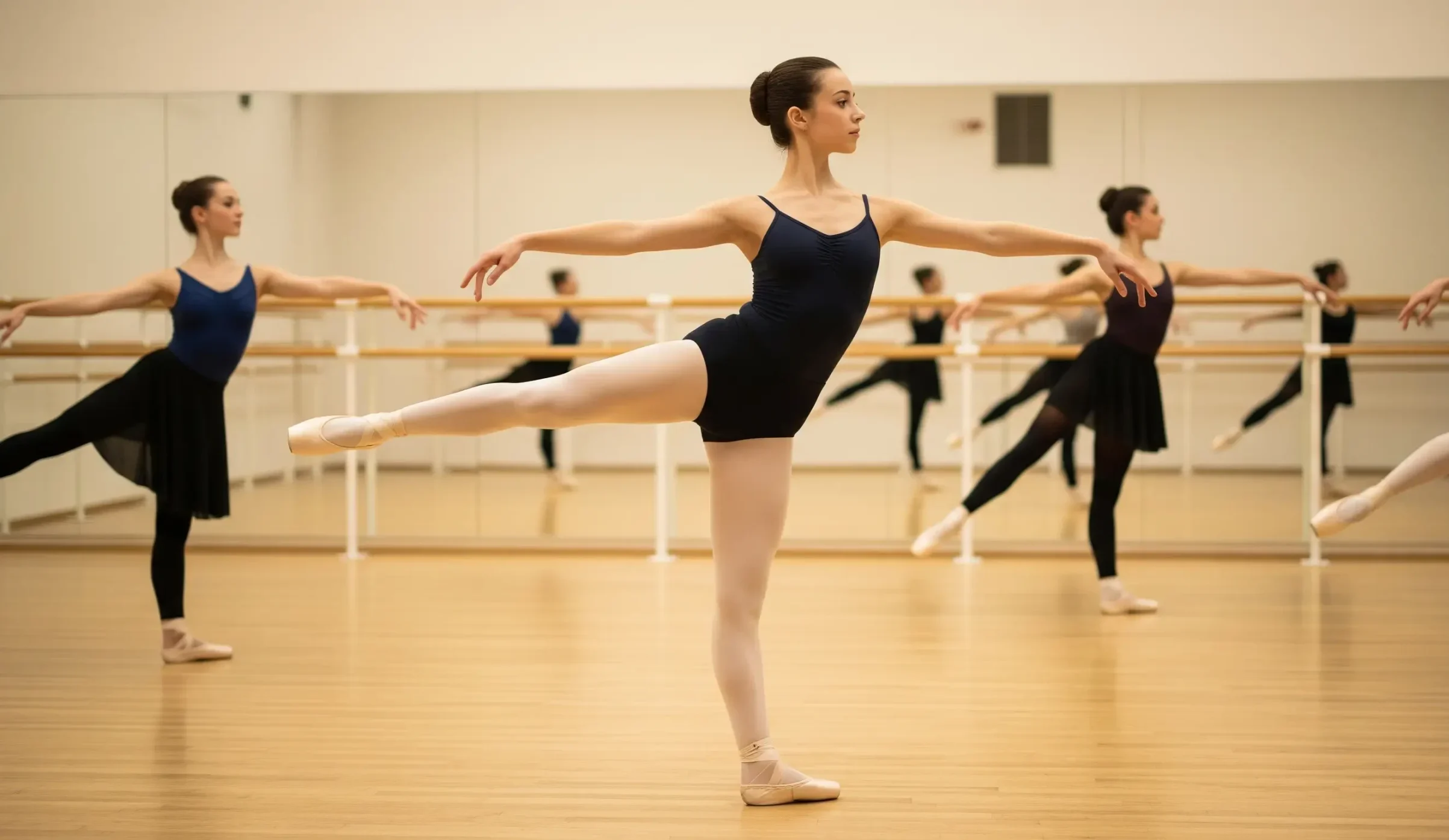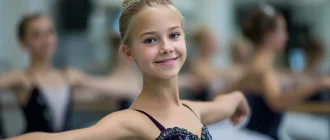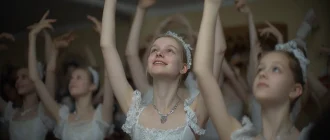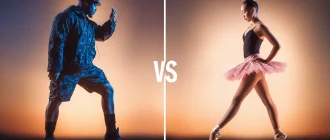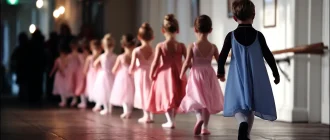In ballet, ‘en croix’—or, as it’s formally known, “en croix definition ballet” — is a French word that means ‘in the shape of a cross,’ involving the working foot in various movements, often following a circular pattern. This term describes movements performed in a sequence: front, side, back, and side again.
These four directions are part of the eight directions used in ballet to describe spatial orientation, with each direction corresponding to a specific stance or position in classical ballet technique. Understanding ‘en croix’ is essential for developing movement, coordination, and balance. In this article, we’ll explore its significance, execution, and common mistakes.
Key Takeaways
- “En croix” refers to a series of ballet movements executed in four directions: front, side, back, and side, which are essential for developing coordination and balance.
- Specific movements such as tendu, battement, and rond de jambe are performed in the “en croix” pattern, aiding in the development of strength, flexibility, and proper technique.
- Practicing “en croix” techniques through barre exercises, center work, and conditioning is essential for enhancing performance and achieving the elegance and precision required in classical ballet.
En Croix Definition Podcast
Introduction to “En Croix” in Ballet
En croix is one of the first concepts dancers encounter in ballet class, and it remains essential throughout a dancer’s training. The phrase, meaning “in the shape of a cross,” describes how steps are performed in a pattern that moves the working leg to the front, side, and back, always returning through the starting position. This cross-like pathway is not just a technical exercise — it’s a foundation for developing balance, alignment, and coordination, particularly of the cou de pied while ensuring the supporting knee remains stable.
During class, dancers often practice en croix at the barre, where the supporting leg provides stability while the working leg moves through each direction. This helps build the strength and control needed for more advanced steps. For example, in movements like pas de chat or pas de basque, the ability to move the working leg confidently in multiple directions, especially while balancing on one leg, is crucial. Mastering en croix prepares dancers for a wide range of ballet steps (pas de), ensuring they have the technical base to progress in their training.
Ballet Positions and Directions
Understanding ballet positions and directions, as well as maintaining a strong upper body, is key to executing movements with precision and artistry. The five basic positions of the feet—first, second, third, fourth, and fifth—form the starting point for most ballet steps. Arm positions, such as bras bas (low), bras moyens (middle), and bras hauts (high), help create the elegant lines that define classical ballet.
Directions in ballet, including en avant (to the front), en arrière (to the back), à la seconde (to the side), and en croix (in a cross pattern), guide dancers on how to move through space. In ballet class, exercises are often structured to move through these directions, helping dancers develop spatial awareness and versatility, especially in second position. For members of the corps de ballet, maintaining correct positions and directions is essential for group unity and the overall visual impact of a performance. Practicing these fundamentals ensures that dancers are prepared for more complex choreography and can move seamlessly between different parts of the stage, whether in la seconde or en avant, including when the dancer turns.
Introduction to “En Croix” in Ballet
En croix is one of the first concepts dancers encounter in ballet class, and it remains essential throughout a dancer’s training. The phrase, meaning “in the shape of a cross,” describes how steps are performed in a pattern that moves the working leg to the front, side, and back, always returning through the starting position. This cross-like pathway is not just a technical exercise—it’s a foundation for developing balance, alignment, and coordination.
During class, dancers often practice en croix at the barre, where the supporting leg provides stability while the working leg moves through each direction. This helps build the strength and control needed for more advanced steps. For example, in movements like pas de chat or pas de basque, the ability to move the working leg confidently in multiple directions is crucial. Mastering en croix prepares dancers for a wide range of ballet steps (pas de), including those that require balancing on one foot, ensuring they have the technical foundation to progress in their training.
Ballet Positions and Directions
Understanding ballet positions and directions is key to executing movements with precision and artistry. The five basic positions of the feet—first, second, third, fourth, and fifth—form the starting point for most ballet steps. Arm positions, such as bras bas (low), bras moyens (middle), and bras hauts (high), help create the elegant lines that define classical ballet.
Directions in ballet, including en avant (to the front), en arrière (to the back), à la seconde (to the side), and en croix (in a cross pattern), guide dancers on how to move through space. In ballet class, exercises are often structured to move through these directions, helping dancers develop spatial awareness and versatility. For members of the corps de ballet, maintaining correct positions and directions is essential for group unity and the overall visual impact of a performance. Practicing these fundamentals ensures that dancers are prepared for more complex choreography and can move seamlessly between different parts of the stage, whether in la seconde or en avant.
Understanding “En Croix” in Ballet
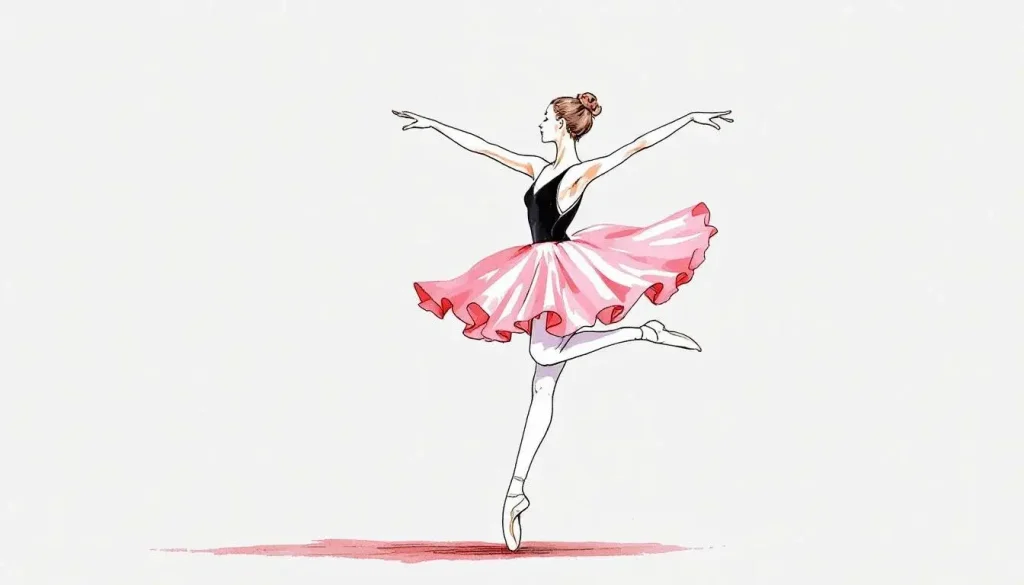
The term “en croix” translates directly to “in the shape of a cross.” This term is a fundamental concept in ballet, describing a series of movements executed in four distinct directions, including the fourth position and the fifth position :
- Front
- Side (de côté)
- Back
- Side again (de côté)
This cross-shaped pattern of movement and circular movements is essential for dancers to master, as it helps develop coordination, balance, and spatial awareness while keeping the supporting knee stable, particularly at the cou de pied, especially during the swinging movement.
In classical ballet, the precision and fluidity of movements are paramount. “En croix” serves as a guiding principle for many ballet steps, ensuring that dancers can execute movements with both grace and accuracy, including the pas de deux and the pirouette en dehors, while maintaining a strong upper body.
Whether you are a beginner in a ballet class or a seasoned performer in a ballet company, understanding and Mastering “en croix” is crucial for achieving the elegance and poise that classical ballet demands, especially when movements are performed en l’air.
Execution of Movements “En Croix” with the Working Leg
Executing movements “en croix” involves a disciplined approach to traverse the front, side, back, and side again, forming a cross-shaped pattern. This pattern is integral to various ballet movements, particularly those that require precise footwork and leg extensions, often involving balancing on one leg. The ability to perform these movements with accuracy, especially with the knee bent when necessary, is a testament to a dancer’s training and skill. The back foot plays a crucial role in maintaining correct alignment and facilitating smooth transitions between each direction during en croix movements.
The cross pattern in ballet involves executing movements in four directions: front, side, back, and side again. “En croix” is especially linked to battements tendus and the pas de chat, where the dancer extends the leg to execute movements in this cross pattern, including the pas de bourrée.
Specific movements executed “en croix,” including tendu, battement, and rond de jambe in en face, will be explored next, providing detailed insights into their execution and importance.
Tendu “en croix” specifically refers to the action of stretching the foot to extend in the following directions, often beginning from an open position:
- Front foot
- Side
- Back
- Side again
This movement is fundamental in ballet as it helps dancers develop the strength and flexibility needed for more complex steps. The precision required in tendu “en croix,” particularly at the cou de pied, also aids in improving a dancer’s overall technique and alignment.
Executing tendu “en croix” involves maintaining a strong and stable core while extending the leg with precision and ensuring a straight knee. The movement begins in the first position and follows these steps, emphasizing the importance of avoiding a slipping movement :
- Extend the first leg to the front (en avant)
- Extend the leg to the side (à la seconde)
- Extend the leg to the back (en arrière)
- Return the leg to the side in a second position, retiré position.
This pattern not only enhances the control and articulation of the working leg but also requires maintaining a strong upward thrust in the waist. But also reinforces the importance of proper body mechanics in ballet, particularly when executing a straight leg.
Battement “En Croix”
The term battement in ballet means “beating.” Battement “en croix” involves executing leg extensions in a cross-shaped pattern, similar to tendu “en croix,” and can often be performed en l’air, as well as in en dehors. There are various types of battements, including grands battements and petits battements, each serving a different purpose in ballet training. Battement en cloche is another type, characterized by a swinging, bell-like movement of the leg that passes through first position and can also be practiced en croix.
A grand battement is executed by throwing the working leg into the air from the hip and bringing it back down to a position en bas. This movement can be taken in three directions: devant (front), derrière (back), and à la seconde (to the side). Performing battement “en croix” helps dancers develop the strength and flexibility needed for more advanced movements, including pirouette en dedans, while also improving their ability to maintain proper alignment and technique en dehors, pas de, half turn, and en dedans.
Daily practice of battement “en croix” builds the muscle memory and precision necessary for ballet. Practicing these movements in a structured, cross-shaped pattern enhances overall coordination and control, making performances both powerful and graceful.
Rond de Jambe “En Croix”
Rond de jambe “en croix” involves circular leg movements that follow a cross-shaped trajectory. This elegant movement is crucial for developing the fluidity and grace that are hallmarks of classical ballet. The rond de jambe “en croix” is performed by extending the leg in a circular motion through the following positions:
- Starting from the front
- Moving to the side
- Then to the back
- Finally returning to the side
Executing a rond de jambe “en croix” requires a strong and stable supporting leg, as well as precise control of the working leg. The movement begins in the first position, with the dancer in the fifth position:
- Extending the leg forward in a circular motion
- Brushing the floor as the leg moves to the side
- Moving the leg back
- Finally returning the leg to the side
This pattern helps dancers develop the necessary flexibility and strength for more advanced dance movements, slow raising dance steps, and ballet steps.
En Croix Variations
En croix is not limited to a single type of movement—it can be adapted and varied to suit different exercises and choreography. In ballet class, dancers might perform tendus, dégagés, or ronds de jambe en croix, each requiring the working foot to trace the cross-shaped pattern while the supporting leg maintains balance and turnout. These variations help dancers refine their technique, improve coordination, and build muscle memory.
As dancers advance, en croix can be incorporated into more dynamic movements, such as jumps or turns. For instance, a grand jeté en croix challenges the dancer to leap en l’air in multiple directions while maintaining control and alignment. The interplay between the working foot and supporting leg is crucial in these variations, as it ensures stability and fluidity throughout the movement. Mastering en croix variations is a testament to a dancer’s technical skill and understanding of ballet fundamentals.
En Croix Variations
En croix is not limited to a single type of movement—it can be adapted and varied to suit different exercises and choreography. In ballet class, dancers might perform tendus, dégagés, or ronds de jambe en croix, each requiring the working foot to trace the cross-shaped pattern while the supporting leg maintains balance and turnout. These variations help dancers refine their technique, improve coordination, and build muscle memory.
As dancers advance, en croix can be incorporated into more dynamic movements, such as jumps or turns. For instance, a grand jeté en croix challenges the dancer to leap in multiple directions while maintaining control and alignment. The interplay between the working foot and supporting leg is crucial in these variations, as it ensures stability and fluidity throughout the movement. Mastering en croix variations is a testament to a dancer’s technical skill and understanding of ballet fundamentals.
Importance of “En Croix” in Ballet Training
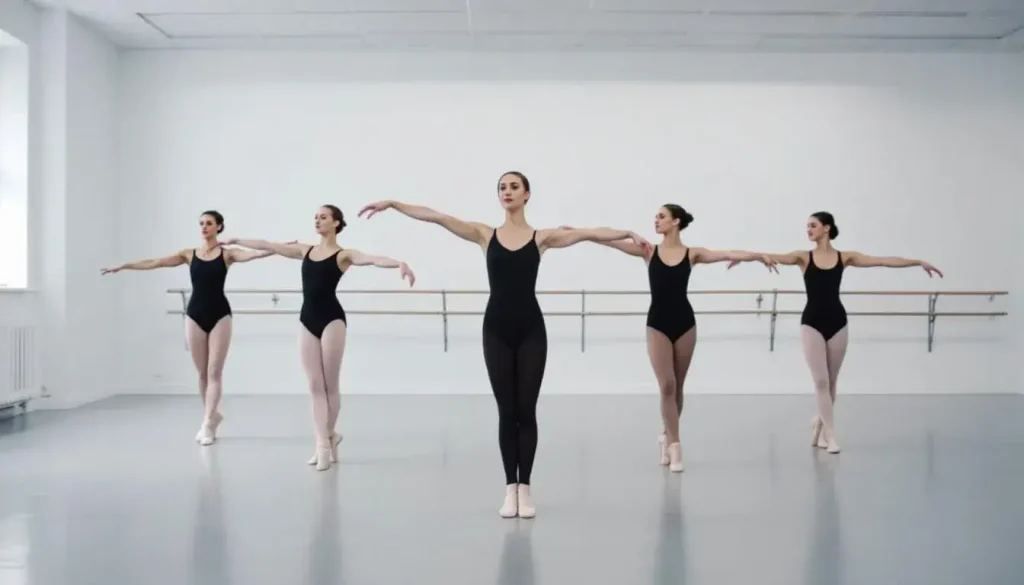
The term “en croix” is significant in ballet as it structures exercises to enhance coordination and spatial awareness. Practicing in multiple directions helps dancers understand their body’s capabilities and limitations more comprehensively. This multidirectional approach is rooted in classical ballet training methods, guiding dancers through various directional movements that are essential for their overall development and growth.
Practicing pliés at the barre regularly, which involve a half bend of the knees (demi-plié), builds foundational strength for more advanced “en croix” techniques. Center work routines with “en croix” patterns enhance a dancer’s balance and stability. These exercises, including port de bras, are crucial for developing the control and precision required for executing movements “en croix” with grace and accuracy.
However, dancers often face challenges when practicing “en croix.” Maintaining proper alignment, engaging the core, and coordinating head and eye movements with the opposite foot and the other leg are all essential for executing “en croix” effectively. Failing to transition smoothly between positions can result in a disjointed appearance in dance sequences, underscoring the importance of consistent practice and attention to detail.
Common Mistakes and How to Avoid Them
Many dancers misinterpret the term “en croix,” leading to incorrect execution of the movements. One of the most common mistakes is failing to maintain a proper cross pattern during steps, which can disrupt the flow and precision of the dance. Additionally, dancers often overlook the importance of muscle engagement, resulting in wobbly movements that lack control and stability.
Incorrect body alignment during “en croix” movements can cause discomfort and hinder performance. Maintaining straight knees during en croix movements is essential for correct technique and aesthetics, as bent knees can compromise both alignment and the overall look of the step. Correcting these mistakes involves focusing on proper technique, including the swinging movement during the execution of “en croix.”
- Regularly practicing alignment drills.
- Seeking feedback from instructors
- Using visualization techniques to better anticipate and correct “en croix” patterns, ensuring accurate and graceful movements.
Focusing on proper technique and consistent practice of “en croix” movements helps dancers overcome common mistakes and enhance overall performance. Regular feedback and guidance from instructors, combined with diligent practice, are key to mastering the elegance and precision required in ballet.
Ballet Class Exercises to Improve “En Croix” Technique
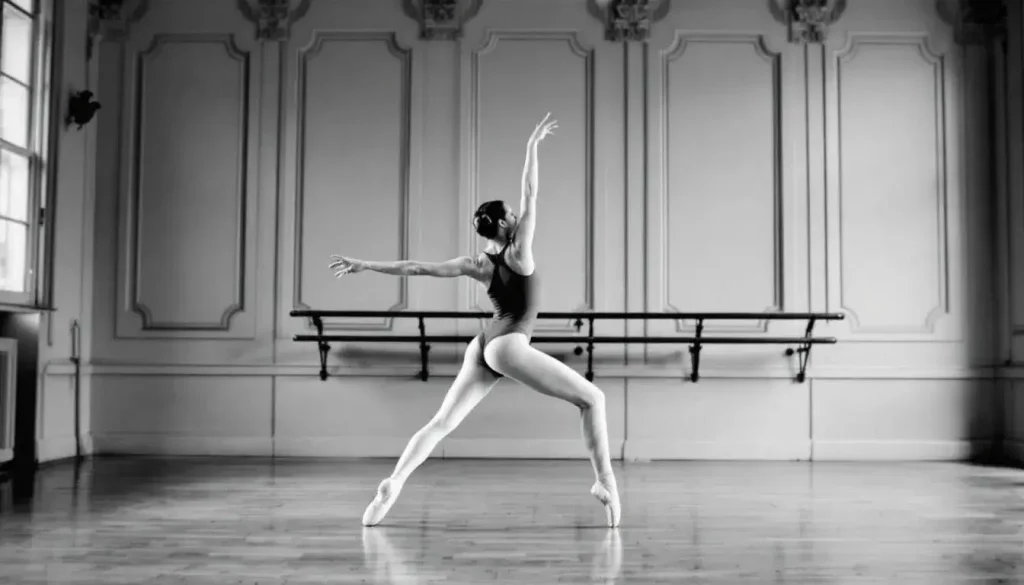
Improving “en croix” technique requires a combination of specific exercises that focus on strength, flexibility, and precision. Practicing movements “en croix” helps dancers develop muscle memory and precision in footwork. Practicing en croix movements on one foot is especially valuable for building balance and stability. Incorporating various exercises into daily practice is essential for mastering “en croix” movements.
The “en croix” pattern helps develop the necessary strength and flexibility for more complex movements. By consistently practicing tendus “en croix” in the en face position, dancers can improve their awareness of body alignment and proper leg placement.
The following sections will outline specific exercises that can be performed at the barre, in the center, and through stretching and conditioning routines.
Barre Exercises
Barre exercises are fundamental to ballet training, providing a solid foundation for developing muscle memory and precision. Battement “en croix” helps dancers build strength in their legs while improving their ability to execute precise movements, which are essential in character dance. This exercise involves executing a leg extension to the front, side, and back, enhancing control and articulation. It is important to maintain extended legs throughout battement en croix to ensure correct form and build strength.
Plié exercises, which involve bending the knees and maintaining a bent knee position, are also crucial for preserving technique and strength in ballet. These exercises, particularly in second or fourth position, help build the foundational strength necessary for more advanced “en croix” techniques. By consistently practicing these barre exercises, dancers can develop the control and precision required for executing movements “en croix” with grace and accuracy.
Center Work
Center work refers to exercises performed in the center of the studio, away from the barre, to develop balance and control in movements. Incorporating “en croix” patterns in center work routines, especially in open position, helps dancers reinforce movement precision and coordination across multiple directions. Practicing en croix patterns on one or two feet is essential for improving balance and versatility, as it prepares dancers for a variety of movement transitions. Engaging in center work that utilizes “en croix” patterns significantly enhances a dancer’s ability to maintain balance and control during performances.
Stretching and conditioning exercises can complement center work routines, improving overall flexibility and strength essential for executing “en croix” movements effectively. By practicing these exercises regularly, including the pas de valse, dancers can enhance their ability to perform “en croix” with accuracy and grace, ensuring that their performances are both powerful and elegant, often at twice the speed.
Stretching and Conditioning
Stretching and conditioning are essential for dancers to enhance their flexibility and strength, which are crucial for executing “en croix” movements. Effective stretching techniques not only increase the range of motion but also contribute to injury prevention in ballet performances, particularly during the development of movement. Incorporating dynamic stretches, such as leg swings, can help improve the flexibility necessary for executing “en croix” with precision.
Conditioning exercises, such as planks and squats, are useful for building the core and leg strength required to maintain balance during “en croix” patterns. Regular practice of strength training routines can significantly enhance a dancer’s ability to perform “en croix” shapes effectively.
Incorporating stretching and conditioning exercises into daily practice improves overall performance and reduces the risk of injury.
Ballet Step Progressions
Ballet step progressions are sequences that link individual steps into a flowing combination, allowing dancers to practice transitions and build stamina. In class, a typical progression might start with a tendu, move into a dégagé, and finish with a rond de jambe, all performed en croix or in other directions, such as à la seconde or en avant. These progressions help dancers internalize the mechanics of each step while focusing on smooth transitions and musicality.
Maintaining position en bas (a low, grounded position) during these progressions is important for proper alignment and balance. As dancers become more comfortable, step progressions can include more complex elements, such as turns or jumps, challenging them to maintain technique and artistry throughout. Practicing these sequences in ballet class prepares dancers for the demands of choreography, where multiple steps must be performed seamlessly and with confidence.
Ballet Step Progressions
Ballet step progressions are sequences that link individual steps into a flowing combination, allowing dancers to practice transitions and build stamina. In class, a typical progression might start with a tendu, move into a dégagé, and finish with a rond de jambe, all performed en croix or in other directions, such as à la seconde or en avant. These progressions help dancers internalize the mechanics of each step while focusing on smooth transitions and musicality.
Maintaining position en bas (a low, grounded position) during these progressions is important for proper alignment and balance. As dancers become more comfortable, step progressions can include more complex elements, such as turns or jumps, challenging them to maintain technique and artistry throughout. Practicing these sequences in ballet class prepares dancers for the demands of choreography, where multiple steps must be performed seamlessly and with confidence.
“En Croix” in Different Ballet Schools

Each ballet school has its approach to teaching concepts like “en croix,” a French word influenced by historical and cultural contexts. The French school of ballet, characterized by its lightness and fluidity, emphasizes intricate footwork and the shaping of the body, particularly through épaulement. The Cecchetti method, widely adopted in French ballet, emphasizes poise and elegance, heavily influenced by the teachings of Enrico Cecchetti.
English ballet, associated with the Royal Academy of Dance, combines elements of various styles, prioritizing grace and meticulous detail. The Russian school style, particularly the Vaganova method, is renowned for its technical precision and emotive storytelling, with a focus on fluidity and dramatic movement. Russian schools, especially those following the Vaganova method, have distinct arm positions and techniques that set them apart from other methods, such as the French or Cecchetti methods. These differences are emphasized in their training and choreography.
By understanding these different approaches, dancers can gain a deeper appreciation for the diversity and richness of ballet training worldwide.
En Croix in Ballet Choreography
En croix is a versatile tool in the hands of choreographers, adding structure and visual interest to both classical and contemporary ballet works. In a pas de deux, for example, partners may mirror each other’s en croix movements, such as en dehors in a coupé jeté en tournant, creating a sense of harmony and connection. Ballet companies often use en croix patterns in group dances to form striking stage pictures and highlight the unity of the corps de ballet.
Famous ballets like Swan Lake and The Sleeping Beauty feature en croix movements in their choreography, showcasing the dancers’ technical prowess and the elegance of the style. Even in character dances, such as those inspired by Polish folk dance, en croix can be used to add variety and rhythmic complexity. Whether in a grand classical production or a lively folk-inspired piece, en croix remains a fundamental element that enhances both the technical and artistic aspects of ballet performance.
En Croix in Ballet Choreography
En croix is a versatile tool in the hands of choreographers, adding structure and visual interest to both classical and contemporary ballet works. In a pas de deux, for example, partners may mirror each other’s en croix movements, such as in a coupé jeté en tournant, creating a sense of harmony and connection. Ballet companies often use en croix patterns in group dances to form striking stage pictures and highlight the unity of the corps de ballet.
Famous ballets like Swan Lake and The Sleeping Beauty feature en croix movements in their choreography, showcasing the dancers’ technical prowess and the elegance of the style. Even in character dances, such as those inspired by Polish folk dance, en croix can be used to add variety and rhythmic complexity. Whether in a grand classical production or a lively folk-inspired piece, en croix remains a fundamental element that enhances both the technical and artistic aspects of ballet performance.
Practical Applications in Ballet Performances
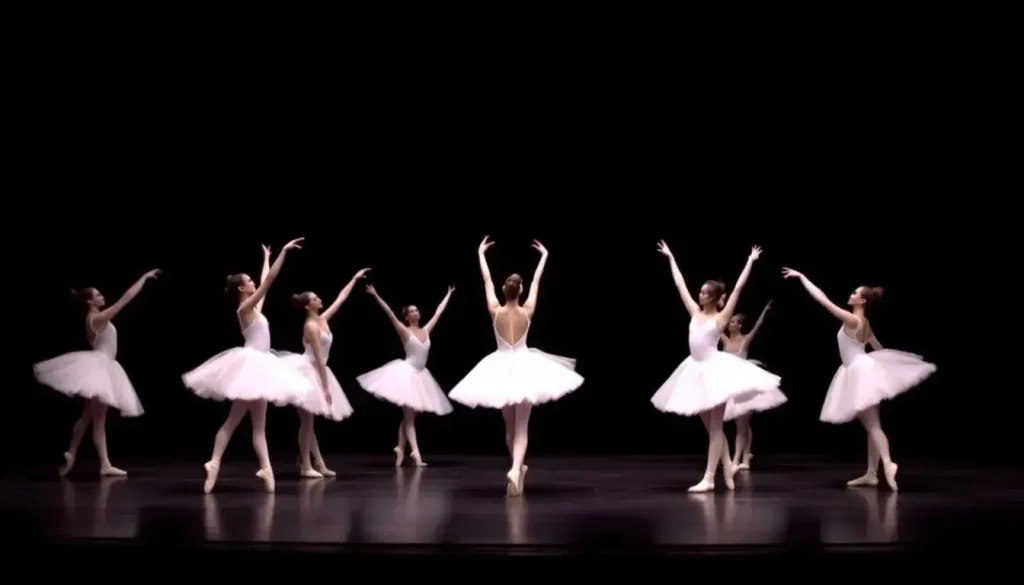
“En croix” movements are essential in ballet, enhancing storytelling and artistic expression through various famous works. One of the most renowned ballets, “Swan Lake,” prominently features “en croix” movements, showcasing fluid transitions and expressive storytelling. In “Romeo and Juliet,” the use of “en croix” movements enhances the emotional depth of the characters, particularly during pivotal dance scenes.
The classical walk is also frequently used in ballet performances to convey elegance, nobility, and poise on stage, contributing to the regal bearing of ballerinas and their partners.
The ballet “The Sleeping Beauty” utilizes “en croix” movements to depict the grace and poise of Princess Aurora, particularly in her solo variations. In “The Nutcracker,” “en croix” movements, including the pas de bourrée, are integrated into the choreography of the Sugar Plum Fairy, adding to her elegance and charm.
Examining these practical applications helps dancers understand how “en croix” enhances the overall impact of ballet performances.
| Aspect | Details | Why It Matters |
|---|---|---|
| Definition | En Croix means “in the shape of a cross” in French. It refers to a movement pattern performed from front to side, then to back, and finally to the side again. | Establishes symmetrical technique and muscle balance through repetition in four directions. |
| Common Uses | Applied in tendus, dégagés, battements, and rond de jambe during barre and center. | Builds strength, coordination, and spatial memory. |
| Training Focus | Precision of direction, consistent height, and turnout in each leg gesture. | Key for refining control, posture, and alignment across all ballet levels. |
Summary
Mastering “en croix” is a crucial aspect of ballet training that enhances coordination, balance, and spatial awareness. By understanding and practicing movements in a cross-shaped pattern, dancers can develop the precision and control needed for more advanced steps. Regular practice, attention to proper alignment, and incorporating specific exercises into daily routines are essential for mastering this fundamental concept.
In conclusion, “en croix” is not just a technical requirement but a cornerstone of classical ballet. Its importance is evident in both training and performances, where it enhances storytelling and artistic expression. By focusing on proper technique and consistently practicing “en croix,” dancers can achieve the elegance and poise that define ballet. Keep practicing, stay dedicated, and let the beauty of “en croix” elevate your dance to new heights.

